Two large embalming workshops for humans and animals, along with two ancient Egyptian tombs and other artefacts were discovered at the Bubasteion necropolis of the sacred animals in Saqqara by an Egyptian mission.
An announcement about the new finds was made on Saturday by the mission which was headed by Secretary-General of the Supreme Council of Antiquities, the executive arm of the Ministry of Tourism and Antiquities, Mostafa Waziry.
Saqqara served as the necropolis of the ancient Egyptian capital, Memphis. It is one of the largest royal necropolises in Egypt, housing – among other things – the oldest stone building in history the Step Pyramid of Djoser.
The area is also home to many other pyramids of kings and queens as part of the Memphis necropolis which is on UNESCO’s World Heritage List.
Tourism and Antiquities Minister Ahmed Issa, who attended the unveiling of the new finds on Saturday, said he bore witness to the hard work made by the Egyptian mission.
“I witnessed their hard work during my visit to the necropolis of the sacred animals last month,” the minister said.
New discoveries, Minister Issa said, help promote Egypt and its incredible tourist destinations.
“I assure everybody that Egypt, especially the archaeological site of Saqqara, have not yet revealed all its secrets,” the minister said. “Many more secrets will come.”
Waziry said the new discovery is important for understanding the embalming methods of ancient Egyptians.
The two discovered workshops, he said, date back to the 30th Dynasty and the Ptolemaic periods.
He added that his mission uncovered two tombs that belong to the Old and New Kingdoms, along with a number of other archaeological finds.
Waziry noted that the human embalming workshop discovered is rectangular and made of mud brick.
It is divided, he said, into a number of rooms with beds where the deceased were lied down for mummification.
He added that each bed is two meters long and 50 cm wide.
“Inside the workshop, there are a large number of clay pots, linen and black resin used in mummification as well as ritual vessels,” Waziry said.
As for the animal embalming workshop, he added, it is also rectangular in shape and made of mud bricks, with an entrance with limestone floor from the inside, divided into a number of rooms.
He added that it consists of a group of rooms, inside which a collection of clay pots and burials for animals were found along with bronze tools used in the mummification process.
He noted that the workshop has five beds made of stone, different than those found inside the human embalming workshop.
The Egyptian mission also uncovered two tombs, the first of a person named ‘Ne Hesut Ba’ (2400 BC), an employee of the Old Kingdom of the Fifth Dynasty (about 2400 BC). The same person held many religious and administrative titles, including the priest of the Horus and Maat, and the supervisor of digging canals.
The walls of this tomb are decorated with views of everyday life, such as forests, agriculture and fishing.
The second tomb belongs to a person, named ‘Men Kheber’, from the New Kingdom’s 18th Dynasty (1400 BC).
He was a priest of the goddess Qadesh, known as the ‘Lady of the Stars of Heaven’ and the ‘Beloved of Ptah’.
The tomb is decorated with scenes of the deceased in different positions before offering tables.
Inside the tomb, a niche was found with a one-meter-long alabaster statue of the tomb’s owner. He is shown sitting on a chair, wearing a wig, and holding the lotus flower with his left hand on his chest.
On the body of the statue, there are three lines of hieroglyphs in blue in a vertical position, bearing the name and titles of the cemetery owner.
The mission also found a group of clay pots, containing goat cheese. They date back to 600 BC. They also found wooden statues of the god Ptah-Sokar-Osiris, in addition to a collection of ushabti figurines.
The Egyptian mission started its work at the Bubasteion cemetery site in 2018. It made a number of discoveries, including the tomb of Wahtye of the Fifth Dynasty in Egypt.
Attending the ceremony held by the Ministry of Tourism and Antiquities to declare the new finds in Saqqara was a host of foreign ambassadors, directors of foreign institutes in Cairo, and dozens of local and foreign journalists and photographers.
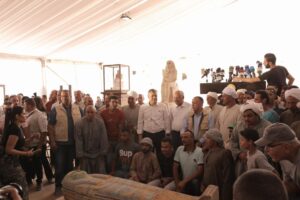

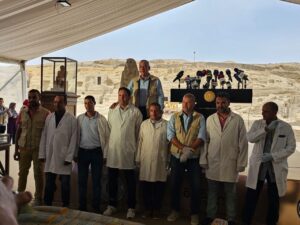
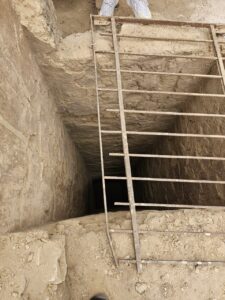
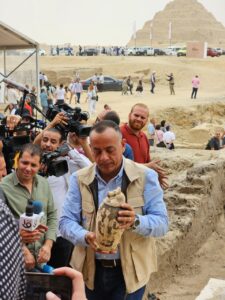
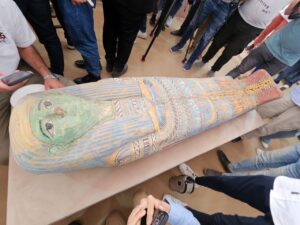
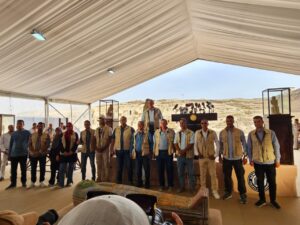

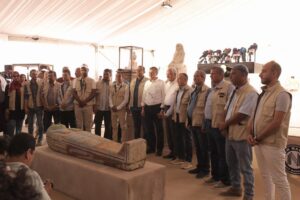



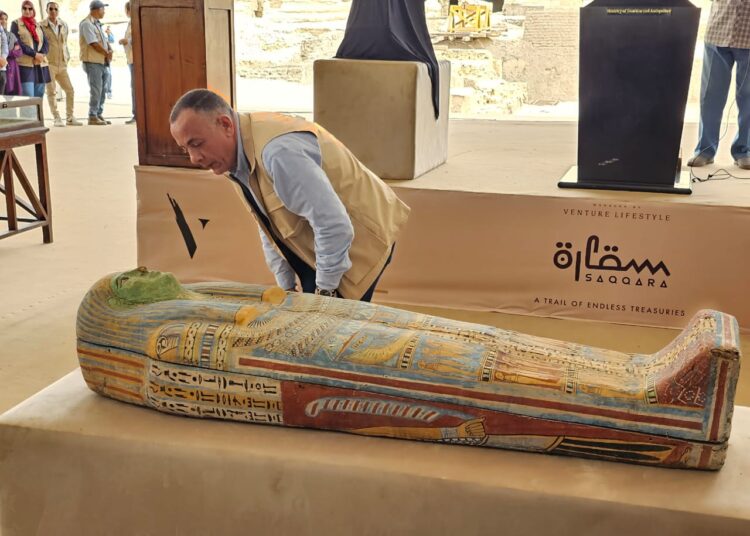


Discussion about this post